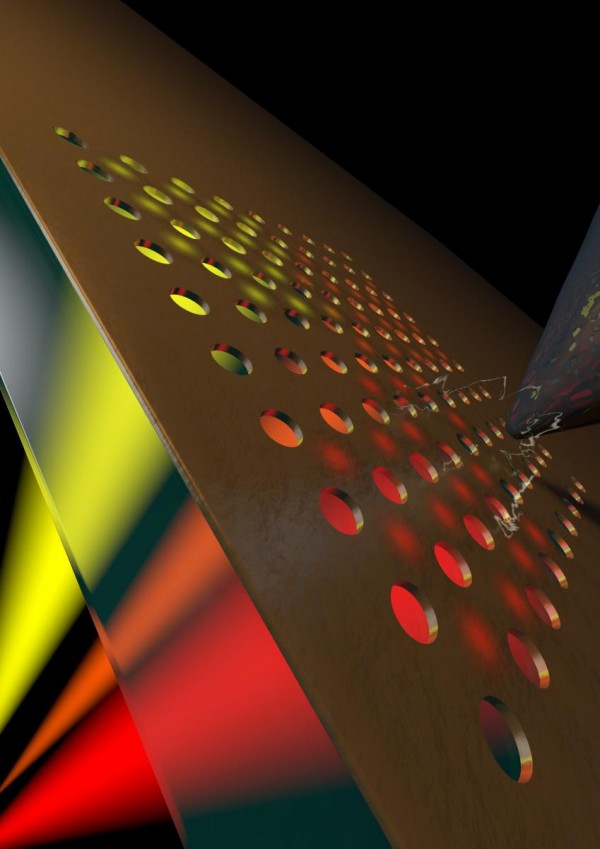Newly Discovered 'Plasmoelectric Effect' Converts Light into Electricity
| Marc Maligalig | | Oct 31, 2014 12:12 PM EDT |
(Photo : Amolf/Tremani) Artist's impression of the plasmoelectric effect. An ultrasensitive needle measures the voltage that arises if a laser illuminates a metal nanocircuit consisting of a square matrix of miniscule holes in a thin gold film
Researchers from the California Institute of Technology and the FOM Institute AMOLF have discovered a new method for the production of electrical potentials by using minute metal nanocircuits to effectively capture light and convert it into an electrical potential of 100 millivolts.
Like Us on Facebook
The AMOLF-Caltech team has named the newly discovered effect the "plasmoelectric effect."
"This is an entirely new way of converting light into electricity," Albert Polman, leader of the AMOLF part of the team, said. "We have now demonstrated that an electrical voltage can be generated; the next step is to see whether we can also collect electrical current and generate electrical power."
Small particles of precious metals such as gold, silver and copper have been noted to emit colorful spectrums when they are illuminated. A well-known example of the phenomena is stained-glass windows in old buildings and churches in which the colors are produced by the metal nanoparticles that have been integrated in the glass. The shining light on the small particles are converted into plasmons, which are oscillations of the free electrons of the metal.
The oscillations result in strong absorption of light and its diffraction into particular colors of the spectrum.
The team investigated the process of light absorption in synthetically manufactured metal nanostructures by creating them with the aid of advanced clean room methods. They illuminated nanospheres of gold with light and found that a negative electrical potential arose when blue light was used to light them. When red light was used to illuminate the nanospheres on the other hand, they were met with a corresponding positive potential.
The scientists measured the electrical voltage using an ultrasensitive needle that was placed above the nanoparticles that were being illuminated and were able to receive a hundred millivolts.
Tagsrenewable energy, solar power, Plasmoelectric effect, Green energy, Nanoparticles, gold, Silver, Copper, Light
©2015 Chinatopix All rights reserved. Do not reproduce without permission
EDITOR'S PICKS
-

Did the Trump administration just announce plans for a trade war with ‘hostile’ China and Russia?
-

US Senate passes Taiwan travel bill slammed by China
-

As Yan Sihong’s family grieves, here are other Chinese students who went missing abroad. Some have never been found
-

Beijing blasts Western critics who ‘smear China’ with the term sharp power
-

China Envoy Seeks to Defuse Tensions With U.S. as a Trade War Brews
-

Singapore's Deputy PM Provides Bitcoin Vote of Confidence Amid China's Blanket Bans
-

China warns investors over risks in overseas virtual currency trading
-

Chinese government most trustworthy: survey
-

Kashima Antlers On Course For Back-To-Back Titles
MOST POPULAR
LATEST NEWS
Zhou Yongkang: China's Former Security Chief Sentenced to Life in Prison

China's former Chief of the Ministry of Public Security, Zhou Yongkang, has been given a life sentence after he was found guilty of abusing his office, bribery and deliberately ... Full Article
TRENDING STORY

China Pork Prices Expected to Stabilize As The Supplies Recover

Elephone P9000 Smartphone is now on Sale on Amazon India

There's a Big Chance Cliffhangers Won't Still Be Resolved When Grey's Anatomy Season 13 Returns

Supreme Court Ruled on Samsung vs Apple Dispute for Patent Infringement

Microsoft Surface Pro 5 Rumors and Release Date: What is the Latest?










